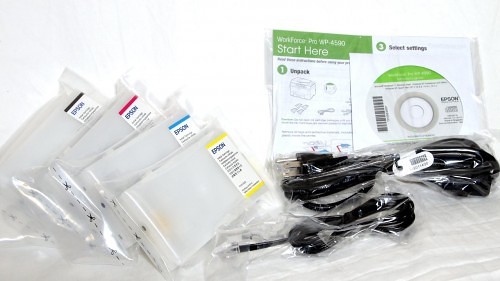
As much as we’d like to move toward a completely digital lifestyle, physical paper still serves a very important role in our daily lives and this is particularly true when it comes to running a business. While the EPSON WorkForce Pro WP-4590 probably isn’t suitable for a high-volume office in a downtown high-rise, it does appear to be a suitable multi-function solution for much smaller offices or home offices. But how does it stand up against daily use and abuse? What can we expect in terms of usability and bonus features? And what about print speed and quality? Let’s dive straight into these questions and more with today’s review.
Feature Overview
Let’s get one thing clear. The WorkForce Pro WP-4590 multifunction printer is “engineered for business.” It can be perfectly useful to a typical multi-computer home, but it was designed for people who need business-level quality, reliability and speed. Not surprisingly, this EPSON takes on the rather typical “beige box” look, which unlike the dramatically different Lexmark Genesis S815 and others like it. After all, this isn’t about looks; it’s about functionality.

The WP-4590 is a multifunction colour printer with PCL. In addition to the printer, you’ll find both a feed and flatbed scanner, including support for full duplexing. Tack on the printing and you’ve got yourself a colour copier. Finally, there is a phone line connection in the back to provide you with fax functionality. The copy and fax can operate independently of a computer, but the printing will need either a USB connection or a network connection. You can scan to a USB device or to a connected computer.
Key features include ISO print speeds of up to 16ppm black and 11 ppm in colour, mobile printing capabilities via EPSON Connect, support for Apple AirPrint and Google Cloud Print, 30-page duplex ADF, and a maximum print resolution of 4800 x 1200 optimized dpi. The main paper tray has a capacity of 250 sheets, plus an additional 80 sheets through the rear feed tray.
Epson is quick to point out that this WorkForce Pro is Energy Star qualified and RoHS compliant. By going with the inkjet route, for instance, Epson says that this uses up to 70% less power than an equivalent laser printer. The automatic two-sided printing option can save you up to 50% on paper costs too. All of these features are available for an MSRP of around $499 USD at most major retailers.
Replacement cartridges are also a factor to consider. Black cartridges come in two sizes: XL ($38.49 US) and XXL ($52.99 US). The color cartridges also give you two sizes and range in price from $24.49 – $58.99 US.
Typically, users will run out of black before the color cartridges, so this does give some reprieve to the long term costs. In the past, you’d only have one size of cartridge as a choice to get your machine running again. With the option to buy less expensive, smaller versions of needed supplies, the different sizes can even be mixed so if you buy an XL, it can sit with the XXL cartridges, allowing you to better control supply costs.
What’s In the Box?

Much like the beige multifunction printer it contains, the brown cardboard box for the WP-4590 isn’t the most exciting thing in the world. The contents of said box are also right in line with what you’d expect. There are the four DuraBrite Ultra ink cartridges (black, cyan, magenta, and yellow), which should provide you with enough ink for about 1,000 black and 900 colour pages. Aside from that, you get the instruction booklets, driver CD-ROM and power cord. There is no USB or Ethernet cable included, so you will need to provide those on your own.
Getting It All Setup

After taking everything out of the box, it was time to get the WP-4590 up and running. I plugged in the power and followed the instructions. There are four inkjet cartridges, as mentioned earlier. The translucent white cartridges are almost a little deceiving, because they don’t look like they contain any ink. In any case, you give them a little shake and then they easily “click” into each of their corresponding spots behind the front cover.
Along with the setup process, I also had to set the language, the date and the time. In terms of getting it all set up with the computer, the process was similar to what I had with the Epson WorkForce 600 some time back, but the software appears to be much more streamlined this time around. I went with the “typical” installation settings and let the wizard work its magic. This installs not only the drivers, but also the Epson software for scanning and such.
While this MFP is network capable, I opted for a straight USB 2.0 connection. It is quite unfortunate that it does not have any built-in wireless capabilities, however, limiting your options in terms of where to put it. My router isn’t in the same room as my computer, so that just won’t do.


